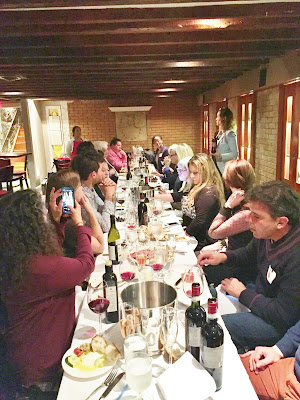A couple weeks ago I
was invited by Balzac Communications to attend a wine tasting
featuring Vino Nobile di Montepulciano followed by a wine dinner with
representatives from a number of wineries. Those wineries included:
Unfortunately, due
to work commitments I couldn’t attend the tasting, but jumped on
the opportunity to have a dinner paired with these “noble wines”
of Montepulciano. The dinner was held in Boston’s historic Italian
section of Boston known as the North End at Ristorante Lucia. We
were swimming in wines to say the least, so I wish I had attended the
tasting so I could have given more focus to each one as the table was
lined with close to 20 bottles and food was being passed around.
Below is a preview into the food of our evening:
Appetizers:
Sauteed
Mussels & Antipasto Della Casa
Pasta:
Pasta
al Forno, Risotto con Porcini
Entrée:
Sogliola
Margherita, Pollo Arrabiata, Vitello Marsala
Dessert:
Cookies,
Italian pastries or Cannoli
Representatives
spoke briefly about some of their wines and the wineries they
represented, which I will highlight in upcoming blogs when I share
with you 1-2 of my favorite wineries of the night, Montemercurio
and Le Berne. I've visited
Poliziano before as you can see from my previous article and I've
done a full tasting of Carpineto wines as well and really enjoy both
wineries, but these 2 wineries were new to me and I enjoyed what they
had to offer. I'll dig more into it all next time, but wanted to
share information about this wonderful wine region since I've been
there a couple times now as well as what exactly vino nobile wines.
Visiting
Montepulciano
The town of
Montepulciano is located within the region of Tuscany, about 70 miles
southwest of Florence. I had briefly visited this Tuscan Renaissance
town years ago and more thoroughly the day after our wedding back in
October 2013. Bring your walking shoes because it's a steep uphill
climb to the top on via di gracciano, but take your time as it's
lined with plenty of shops and cafes to stop and take a break at. My
favorite are the quiet, picturesque alleys that break off from the
main street before arriving at the top to Piazza Grande. I attended
a wine tasting in Piazza Grande at Cantina Contucci and still have
yet to open that bottle, but look forward to it!
 |
| Piazza Grande |
Wine has been
documented to be growing in this area since 790 AD when vineyards
were donated to a local church. In 1966 this area gained D.O.C
status (denominazione di origine controllata) and in 1980 became one
of the first D.O.C.G (denominazione di origine controllata garantita)
designations. The Consorzio just celebrated their 50th
year in 2016.
The current wines
being launched onto the market are the 2014 Vino Nobile di
Montepulciano D.O.C.G., the 2013 Vino Nobile di Montepulciano Riserva
D.O.C.G and the 2015 Rosso di Montepulciano DOC. A preview of the
2016 vintage was rated 4 out of 5 stars by oenologist Emiliano
Falsini. According to the consorzio, the harvest year was highly
favorable for the quality grapes that were selected for production.
The wines are demonstrating intense colors and elegance.
There are about
2,000 hectacres (4,950 acres) of vineyards making up 16% of the total
acreage of land with about 250 wine growers in total. The vineyards
of Montepulciano are situated at about 250-600 meters. The recent
annual production of the area totaled about 7 million bottles of Vino
Nobile and 2.5 million bottles of Rosso di Montepulciano.
The vineyards here
have been highly invested in totaling 8 million dollars in order for
the wineries to practice sustainability. About 70% of the total
wineries in Montepulciano are practicing sustainability.
Biodiversity and organic winemaking is increasing as well with about
40% of the current vino nobile vineyards practicing. The Vino Nobile
DOCG is also undergoing a project that will allow zero impact on the
environment and will be the first winegrowing area within Italy that
will have all bottles to be certified to show this impact of
neutralizing the gas emissions once complete.
What makes up
a Vino Nobile? The wine must be at least 70% prugnolo
gentile, which you're probably familiar with as sangiovese. There is
also allowance of up to 30% of other red Tuscan grapes. The wines can
be released on the market after 2 years of aging and for riservas the
wines must be aged for 3 years with 6 months in the bottle for a
riserva. The consorzio describes vino nobile wines characterists as
ruby red in color changing to garnet with age. They have an intense
and ethereal aroma. On the palate they're dry, balanced and
persistent with spicy notes from the oak aging.

It always surprises
me how much of the wine produced within Italy is exported outside.
Especially in regions such as Tuscany that produce highly
recognizable and valued wines in other countries compared to some of
the lesser known, smaller wine producing regions. Vino Nobile exports
about 78% of their production with the US ranking at the top of the
charts of importation at 21% second to Germany at a whopping 46%.
Have you been
to this region and what are you favorite wineries or wines that
you've tried?















